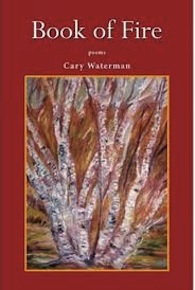Book Review
Book of Fire by Cary Waterman. Nodin Press, 2011. $16
Reviewed by Kathleen Serley
Book of Fire by Cary Waterman is noteworthy for many reasons.
One reason to read Waterman’s poems is to delight in the imagery she chooses. Descriptions such as
water a necklace around tree trunks ( 52)
and
petals kissing grass (11)
or
In the top of the fir trees
the wind is a huge hand
rocking the earth cradle. (49)
are unique ways of seeing the ordinary: high water, drooping flowers and a windy day.
Another reason to read Waterman’s poems is to explore the questions she asks. In "Execution," Waterman contrasts the experience of rocking her granddaughter to sleep with the news report of a young man beheaded in Iraq and asks,
How much does it cost for us to be able to do this,
For me to sit here rocking, watching her sleep? (58)
And in another poem about another war she writes:
We try to fix our mistakes but they stretch out behind us
like phosphorus. Those babies lifted up on fumes,
jet fuel burning behind them,
we would take them home
to mothers and sisters,
to wives, even,
the pool of their mothers’ blood
counting for nothing. (56)
Readers will also note how Waterman employs the poet’s craft with the use of contrast,
The smile of a fish hook (12)
images that help us hear as well as see,
What’s been frozen
over the long dark months
is slowly falling,
small chimes released. (46)
and spacing to give a visual emphasis to the words:
Megadeath
oh how she
shakes
the linden
shimmy shimmy
it’s 90 degrees
and risingghetto blaster thump thump thump
disaster bumping
down
the street (14)
But I think it is above all the pace of Waterman’s poems that make them memorable; her willingness to take all the time she needs to develop her subject and to draw the reader to her vision. This is the experience I enjoyed most while reading these poems.
In the Garden is a good example of a poem that can be read on multiple levels.
1
Zeus, the dog next door,
offers up a laconic bark.
Between lattices of a bamboo cage
tomatoes climb to sun.
All things must be staked up,
the fallen lilies collapsed
like ladies in pink ball gowns,
the clematis with its purple face,
the reluctant roses.
Everything needs help standing.
Going skyward on a ladder to paint
she leans in, feel the rungs kiss her feet.2
Home late, she waters plants,
falls asleep in the garden.
A dog’s chain clinks her awake.
Her flowers, even though she has treated them
so well, fed and fussed over them,
begin to fail. It is almost
August, the pause between bounty
and death. Baby birds have fledged.
Grass yellows. The season turns
like the smile of a fish hook.3
One cloud floats west to east.
In the Japanese Garden at Lake Como
Buddhists celebrate Oban,
light candles to lead home the family ghosts.She does not wish to return there,
feels instead the high thin promise of
a whole life inside her body
even after marriage, children, divorce, death,
the space where a mother and father used to be.She is still that same girl,
her hair on fire.4
Last light on lilies.
It greens only the surface of rapier leaves,
the underside still in shadow.
By the garage a groundhog shuffles
Toward hibernation. In the coldest months
he will breathe only once every minute.What is there finally but gratitude?
She sits in the garden,
does nothing but watch leaves tremble,
sees slotted sun come through the fence,
opens her heart to the forgiveness of a life.
The mourning dove knows her,
comes to the feeder in steelcoat grey,
a peaceful bird with all manner of secrets
and hidden darkness. (12-13)
On one level it is the story of a woman who, after a long day, relaxes in her garden:
Home late, she waters plants,
falls asleep in the garden.
Imagery of Zeus (" … the dog next door") and Persephone ("August, the pause between bounty/and death…") are woven into the poem along with spring and fall, the growing and dying of the garden:
Her flowers, even though she has treated them
so well, fed and fussed over them,
begin to fail.
Then ultimately the reader realizes this is a description of a woman nearing the autumn of her life ("Last light on lilies"), but
she is still the same girl,
her hair on fire.
With this story told, Waterman turns her attention to the larger questions:
What is there finally but gratitude?
She sits in the garden,
does nothing but watch the leaves tremble,
sees slotted sun come through the fence,
opens her heart to the forgiveness of a life.
This last stanza circles back to the description of the garden in the first stanza,
the fallen lilies collapsed
the ladies in pink ball gowns,
the clematis with its purple face,
the reluctant roses.
Which leads to the observation that
Everything needs help standing.
It is always a pleasure to find a poem that can be read like this. A poem that establishes a sense of place, tells a story and encourages readers to explore life’s larger questions. In Cary Wateman’s Book of Fire, you’ll find these accomplished poems with each turn of the page.
A lifelong resident of Wisconsin, Kathleen Serley enjoys all of our seasons: spring gardening, summer beach combing, fall hiking and winter snow shoeing. She teaches English.


